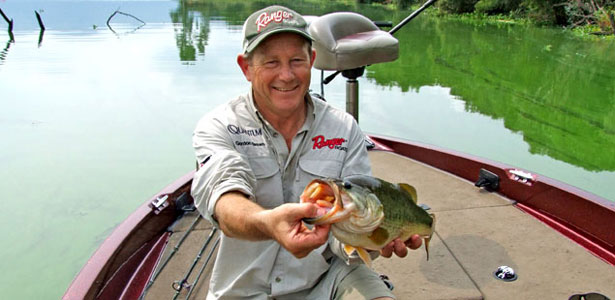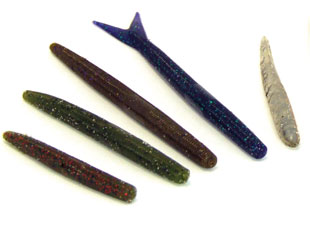
With spring on its way, and most of the cold fronts a thing of the past, it’s time to get into some early pre-spawn bassing and a great lure for this is a soft plastic jerkbait. Plastic jerkbaits are very versatile as they can be fished in so many ways, and come in a variety of shapes, sizes and colours. Who can still remember when the first Sluggo’s came into South Africa and all the fish that were caught on them in the old Heyshope days. Well, soft jerkbaits have continued catching lots of bass, and are still dominating success at major tournaments. The previous South African bass record of 6,29kg was caught by Julian Van Zuydam at Midmar Dam in 2005, using a June Bug Super Fluke.
Soft plastic jerk baits can be used all year round, even in winter. I would like to stress that in the next two months (August and September) one can experience some really sweet bassing with these baits. In spring fish start to move out of their deep water winter areas onto points and start to filter down the banks on to shallow flats to spawn. Bass are still sluggish at this time and are not ready to chase down fast moving lures. That’s why these baits are so effective.
The subtle action of a weightless Senko or Super Fluke sinking with a couple of twitches in between imitate the effects of winter on bait fish, and are difficult for any bass to resist.
As I have mentioned, the variety is endless, but the more popular ones include 5-inch Super Flukes 5”(also look out for the new 7-inch one), finnesse worms, trick worms, Senkos in 4, 5 and 7–inch (even bigger but not used by the faint hearted), Flappin Shads and frogs. I can still recall early in the season one year at Theewaterskloof in the Cape I was using a weightless bubble gum trick worm, fishing the flats and catching 1,5 to 2,5kg fish. What is also great with this type of bait is that you can fish it around or on top of grass or weeds without hanging up as the bait is always hooked weedless, something not possible with normal hard jerkbaits. Remember this method is also great for sight fishing. When you see a fish interested in the bait, experiment to see if they want the bait to sink naturally or twitched to produce a strike. In the case of the trick worms, the twitch - twitch - pause was the deal.
The same applies when using a Flappin Shad. With its great flapping tail action this is an excellent bait when used in heavy cover.
When using Senko or trick type worms, one can vary the action of the bait by placing the hook differently. Instead of inserting the hook in front as normal, thread the worm further down the hook before bringing the hook out (see picture). This method allows the worm to sink slower and horizontally. In the case where you are fishing deeper, a split shot or a #0 mojo sinker can be placed on the line 30 cm or so in front of the bait. This gets the bait down quicker into the strike zone. Alternatively, a lead nail can be inserted into the bait. In addition, rattles can be used in off- coloured water to attract fish when the bait is twitched.
 Plastic frogs have always been around, but with the introduction of the new generation of frogs our bass waters have been exploding as big and small bass cannot resist this new soft jerkbait. Custom rods are now also available, designed specifically for “frogging”. I have recently acquired one of these rods, a 7-foot rod with lots of backbone, a lovely soft tip for twitching and rated for 10lb – 25lb line. Although designed for frogging, it’s a good all round rod for plastic jerk baits. I prefer a 7-foot rod for long casts, and to have good hook setting power. While talking tackle, I recommend using a baitcaster reel with 12lb to 15lb fluorcarbon lines when fishing open water, and 50lb braid in heavy cover. There are two main ways to work frogs - the first is to use a constant retrieve and the other is to use 3 or 4 twitches and a pause that creates a noise. Remember to allow a few seconds for the fish to hit the bait. I have found that the Horny Toad works best with a constant retrieve, whereas the Venom frog has softer legs and produces more action using the twitch- pause technique.
Plastic frogs have always been around, but with the introduction of the new generation of frogs our bass waters have been exploding as big and small bass cannot resist this new soft jerkbait. Custom rods are now also available, designed specifically for “frogging”. I have recently acquired one of these rods, a 7-foot rod with lots of backbone, a lovely soft tip for twitching and rated for 10lb – 25lb line. Although designed for frogging, it’s a good all round rod for plastic jerk baits. I prefer a 7-foot rod for long casts, and to have good hook setting power. While talking tackle, I recommend using a baitcaster reel with 12lb to 15lb fluorcarbon lines when fishing open water, and 50lb braid in heavy cover. There are two main ways to work frogs - the first is to use a constant retrieve and the other is to use 3 or 4 twitches and a pause that creates a noise. Remember to allow a few seconds for the fish to hit the bait. I have found that the Horny Toad works best with a constant retrieve, whereas the Venom frog has softer legs and produces more action using the twitch- pause technique.
So much has been said in the past regarding colours of all the baits I have mentioned. One would need to experiment what works best for you in your area. The basic colours you can count on are the watermelon combinations such as watermelon red, watermelon candy, watermelon purple, June Bug and green pumpkin. For Trick worms use bubble gum, watermelon, June Bug and the fluorescent colours. Flappin Shads in pearl and white are excellent. With frogs through anything goes, from white to June Bug. Combinations of watermelon or green pumpkin with pearl underneath are all good choices.
One other technique that is not often used, but which is very effective when twitching soft plastic jerk baits is to rig the bait “wacky style” (see picture). A 5-inch Senko or finnesse worm is ideal for this technique. Place the hook either directly through the centre of a worm, or use an elastic band around the middle of the worm. These little elastic bands can be obtained from dentists or stationary stores.


 Visit us our
Visit us our